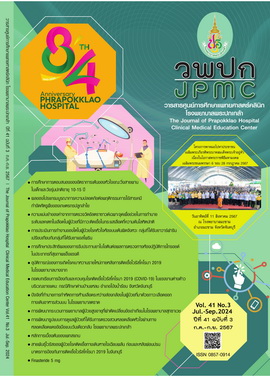Predictor for Endoscopic Intervention in Patient with Upper Gastrointestinal Bleeding in Trat Hospital
Main Article Content
Abstract
BACKGROUND: Upper gastrointestinal bleeding (UGIB) is an urgent medical condition. Endoscopic intervention is one type of management for patients with high-risk stigmata. However, sometimes it can be difficult to evaluate. Therefore, predicting which patients require endoscopic intervention is important.
OBJECTIVES: To determine the predictors for endoscopic intervention and to assess the clinical presentations, endoscopic findings, endoscopic interventions and outcomes of upper gastrointestinal bleeding patients.
METHODS: We conducted a retrospective cohort study in patients diagnosed with upper gastrointestinal bleeding from August 2022 to February 2024. Medical records and endoscopic results were reviewed. Data were obtained using descriptive statistics, the Chi-square or Fisher’s exact test, the Independent t-test or Mann-Whitney U test, and multiple logistic regression analysis.
RESULTS: A total of 269 patients were enrolled, with a mean age of 64 years, and 60.2% were male. Among the 97 patients (36%) who underwent endoscopic intervention compared to those who did not, it was found that they were more likely to present with melena and have fresh blood NG, higher NSAIDS use, more instances of systolic blood pressure (SBP) <100 mmHg, lower hemoglobin levels, and a drop in hematocrit greater than 20% from baseline. Peptic ulcer was the leading cause of UGIB (60.6%), and the most common intervention was combined epinephrine injection with coaptive thermocoagulation (61.9%). Both groups had similar lengths of hospital stay, re-bleeding rates, and mortality rates. The multivariate analysis indicated that significant predictors for endoscopic intervention were NSAIDS use (OR 2.42; 95% CI, 1.23-4.76; p=0.01), Hb level <7 g/dL (OR 4.02; 95% CI, 1.93-8.40; p<0.001), Hct drop >20% from baseline (OR 3.93; 95% CI, 1.97-7.88; p<0.001), SBP <100 mmHg (OR 5.44; 95% CI, 1.69-17.51; p=0.005) and fresh blood NG (OR 9.48; 95% CI, 2.40-37.39; p<0.001).
CONCLUSIONS: Significant predictors for endoscopic intervention in patients with upper gastrointestinal bleeding include NSAIDS use, hemoglobin level <7 g/dL, hematocrit drop >20% from baseline, systolic blood pressure <100 mmHg, and fresh blood NG.
Thaiclinicaltrials.org number, TCTR20240806005
Article Details

This work is licensed under a Creative Commons Attribution-NonCommercial-NoDerivatives 4.0 International License.
References
Okazaki H, Fujiwara Y, Sugimori S, Nagami Y, Kameda N, Machida H, et al. Prevalence of mid-gastrointestinal bleeding in patients with acute overt gastrointestinal bleeding: multi-center experience with 1,044 consecutive patients. J Gastroenterol 2009;44:550-5.
Raju GS, Gerson L, Das A, Lewis B; American Gastroenterological Association. American Gastroenterological Association (AGA) institute technical review on obscure gastrointestinal bleeding. Gastroenterology 2007;133:1697-717.
Gerson LB, Fidler JL, Cave DR, Leighton JA. ACG clinical guideline: diagnosis and management of small bowel bleeding. Am J Gastroenterol 2015;110:1265-87.
Perisetti A, Kopel J, Shredi A, Raghavapuram S, Tharian B, Nugent K. Prophylactic pre-esophagogastroduodenoscopy tracheal intubation in patients with upper gastrointestinal bleeding. Proc (Bayl Univ Med Cent) 2019;32:22-5.
Kamboj AK, Hoversten P, Leggett CL. Upper gastrointestinal bleeding: etiologies and management. Mayo Clin Proc 2019;94:697-703.
Fouad TR, Abdelsameea E, Abdel-Razek W, Attia A, Mohamed A, Metwally K, et al. Upper gastrointestinal bleeding in Egyptian patients with cirrhosis: Post-therapeutic outcome and prognostic indicators. J Gastroenterol Hepatol 2019;34:1604-10.
Sangchan A, Sawadpanitch K, Mairiang P, Chunlertrith K, Sukeepaisarnjaroen W, Sutra S, et al. Hospitalized incidence and outcomes of upper gastrointestinal bleeding in Thailand. J Med Assoc Thai 2012;95 Suppl 7:S190-5.
Thanapirom K, Ridtitid W, Rerknimitr R, Thungsuk R, Noophun P, Wongjitrat C, et al. Prospective comparison of three risk scoring systems in non-variceal and variceal upper gastrointestinal bleeding. J Gastroenterol Hepatol 2016;31:761-7.
Rugivarodom M, Pausawasdi N. Upper gastrointestinal bleeding. In: Maneerattanaporn M, Nimanong S, Kaosombatwattana U, editors. Practical gastroenterology and hepatology. Bangkok: Faculty of Medicine Siriraj Hospital, Mahidol University; 2020. p.83-112.
Laine L, Barkun AN, Saltzman JR, Martel M, Leontiadis GI. ACG clinical guideline: upper gastrointestinal and ulcer bleeding. Am J Gastroenterol 2021;116:899-917.
Gralnek IM, Stanley AJ, Morris AJ, Camus M, Lau J, Lanas A, et al. Endoscopic diagnosis and management of nonvariceal upper gastrointestinal hemorrhage (NVUGIH): European Society of Gastrointestinal Endoscopy (ESGE) guideline-update 2021. Endoscopy 2021;53:300-32.
Kim SS, Kim KU, Kim SJ, Seo SI, Kim HS, Jang MK, et al. Predictors for the need for endoscopic therapy in patients with presumed acute upper gastrointestinal bleeding. Korean J Intern Med 2019;34:288-95.
Pattamayothin S. Cause and risk factors of upper gastrointestinal bleeding in. J Prapokklao Hosp Clin Med Educat Center 2009;26:207-13.
Charatcharoenwitthaya P, Pausawasdi N, Laosanguaneak N, Bubthamala J, Tanwandee T, Leelakusolvong S. Characteristics and outcomes of acute upper gastrointestinal bleeding after therapeutic endoscopy in the elderly. World J Gastroenterol 2011;17:3724-32.
Srygley FD, Gerardo CJ, Tran T, Fisher DA. Does this patient have a severe upper gastrointestinal bleed?. JAMA 2012;307:1072-9.

